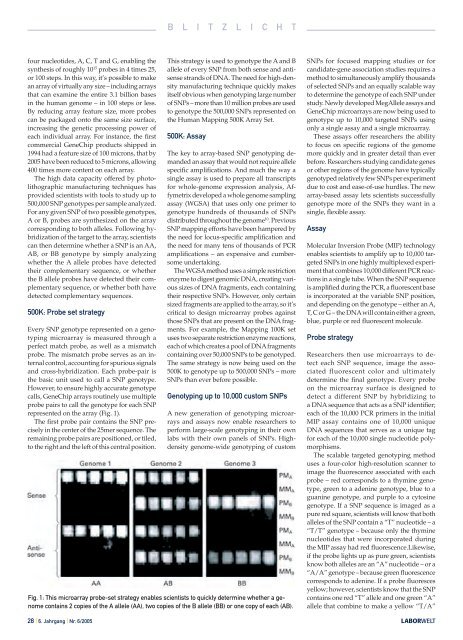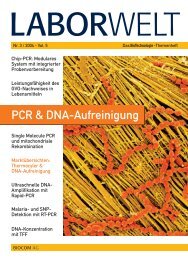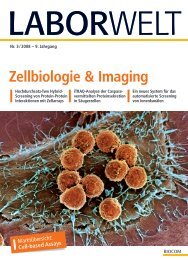PDF Download - Laborwelt
PDF Download - Laborwelt
PDF Download - Laborwelt
Sie wollen auch ein ePaper? Erhöhen Sie die Reichweite Ihrer Titel.
YUMPU macht aus Druck-PDFs automatisch weboptimierte ePaper, die Google liebt.
four nucleotides, A, C, T and G, enabling the<br />
synthesis of roughly 10 15 probes in 4 times 25,<br />
or 100 steps. In this way, it’s possible to make<br />
an array of virtually any size – including arrays<br />
that can examine the entire 3.1 billion bases<br />
in the human genome – in 100 steps or less.<br />
By reducing array feature size, more probes<br />
can be packaged onto the same size surface,<br />
increasing the genetic processing power of<br />
each individual array. For instance, the first<br />
commercial GeneChip products shipped in<br />
1994 had a feature size of 100 microns, that by<br />
2005 have been reduced to 5 microns, allowing<br />
400 times more content on each array.<br />
The high data capacity offered by photolithographic<br />
manufacturing techniques has<br />
provided scientists with tools to study up to<br />
500,000 SNP genotypes per sample analyzed.<br />
For any given SNP of two possible genotypes,<br />
A or B, probes are synthesized on the array<br />
corresponding to both alleles. Following hybridization<br />
of the target to the array, scientists<br />
can then determine whether a SNP is an AA,<br />
AB, or BB genotype by simply analyzing<br />
whether the A allele probes have detected<br />
their complementary sequence, or whether<br />
the B allele probes have detected their complementary<br />
sequence, or whether both have<br />
detected complementary sequences.<br />
500K: Probe set strategy<br />
Every SNP genotype represented on a genotyping<br />
microarray is measured through a<br />
perfect match probe, as well as a mismatch<br />
probe. The mismatch probe serves as an internal<br />
control, accounting for spurious signals<br />
and cross-hybridization. Each probe-pair is<br />
the basic unit used to call a SNP genotype.<br />
However, to ensure highly accurate genotype<br />
calls, GeneChip arrays routinely use multiple<br />
probe pairs to call the genotype for each SNP<br />
represented on the array (Fig. 1).<br />
The first probe pair contains the SNP precisely<br />
in the center of the 25mer sequence. The<br />
remaining probe pairs are positioned, or tiled,<br />
to the right and the left of this central position.<br />
B L I T Z L I C H T<br />
This strategy is used to genotype the A and B<br />
allele of every SNP from both sense and antisense<br />
strands of DNA. The need for high-density<br />
manufacturing technique quickly makes<br />
itself obvious when genotyping large number<br />
of SNPs – more than 10 million probes are used<br />
to genotype the 500,000 SNPs represented on<br />
the Human Mapping 500K Array Set.<br />
500K: Assay<br />
The key to array-based SNP genotyping demanded<br />
an assay that would not require allele<br />
specific amplifications. And much the way a<br />
single assay is used to prepare all transcripts<br />
for whole-genome expression analysis, Affymetrix<br />
developed a whole genome sampling<br />
assay (WGSA) that uses only one primer to<br />
genotype hundreds of thousands of SNPs<br />
distributed throughout the genome 10 . Previous<br />
SNP mapping efforts have been hampered by<br />
the need for locus-specific amplification and<br />
the need for many tens of thousands of PCR<br />
amplifications – an expensive and cumbersome<br />
undertaking.<br />
The WGSA method uses a simple restriction<br />
enzyme to digest genomic DNA, creating various<br />
sizes of DNA fragments, each containing<br />
their respective SNPs. However, only certain<br />
sized fragments are applied to the array, so it’s<br />
critical to design microarray probes against<br />
those SNPs that are present on the DNA fragments.<br />
For example, the Mapping 100K set<br />
uses two separate restriction enzyme reactions,<br />
each of which creates a pool of DNA fragments<br />
containing over 50,000 SNPs to be genotyped.<br />
The same strategy is now being used on the<br />
500K to genotype up to 500,000 SNPs – more<br />
SNPs than ever before possible.<br />
Genotyping up to 10,000 custom SNPs<br />
A new generation of genotyping microarrays<br />
and assays now enable researchers to<br />
perform large-scale genotyping in their own<br />
labs with their own panels of SNPs. Highdensity<br />
genome-wide genotyping of custom<br />
Fig. 1: This microarray probe-set strategy enables scientists to quickly determine whether a genome<br />
contains 2 copies of the A allele (AA), two copies of the B allele (BB) or one copy of each (AB).<br />
SNPs for focused mapping studies or for<br />
candidate-gene association studies requires a<br />
method to simultaneously amplify thousands<br />
of selected SNPs and an equally scalable way<br />
to determine the genotype of each SNP under<br />
study. Newly developed MegAllele assays and<br />
GeneChip microarrays are now being used to<br />
genotype up to 10,000 targeted SNPs using<br />
only a single assay and a single microarray.<br />
These assays offer researchers the ability<br />
to focus on specific regions of the genome<br />
more quickly and in greater detail than ever<br />
before. Researchers studying candidate genes<br />
or other regions of the genome have typically<br />
genotyped relatively few SNPs per experiment<br />
due to cost and ease-of-use hurdles. The new<br />
array-based assay lets scientists successfully<br />
genotype more of the SNPs they want in a<br />
single, flexible assay.<br />
28 | 6. Jahrgang | Nr. 6/2005 LABORWELT<br />
Assay<br />
Molecular Inversion Probe (MIP) technology<br />
enables scientists to amplify up to 10,000 targeted<br />
SNPs in one highly multiplexed experiment<br />
that combines 10,000 different PCR reactions<br />
in a single tube. When the SNP sequence<br />
is amplified during the PCR, a fluorescent base<br />
is incorporated at the variable SNP position,<br />
and depending on the genotype – either an A,<br />
T, C or G – the DNA will contain either a green,<br />
blue, purple or red fluorescent molecule.<br />
Probe strategy<br />
Researchers then use microarrays to detect<br />
each SNP sequence, image the associated<br />
fluorescent color and ultimately<br />
determine the final genotype. Every probe<br />
on the microarray surface is designed to<br />
detect a different SNP by hybridizing to<br />
a DNA sequence that acts as a SNP identifier;<br />
each of the 10,000 PCR primers in the initial<br />
MIP assay contains one of 10,000 unique<br />
DNA sequences that serves as a unique tag<br />
for each of the 10,000 single nucleotide polymorphisms.<br />
The scalable targeted genotyping method<br />
uses a four-color high-resolution scanner to<br />
image the fluorescence associated with each<br />
probe – red corresponds to a thymine genotype,<br />
green to a adenine genotype, blue to a<br />
guanine genotype, and purple to a cytosine<br />
genotype. If a SNP sequence is imaged as a<br />
pure red square, scientists will know that both<br />
alleles of the SNP contain a “T” nucleotide – a<br />
“T/T” genotype – because only the thymine<br />
nucleotides that were incorporated during<br />
the MIP assay had red fluorescence.Likewise,<br />
if the probe lights up as pure green, scientists<br />
know both alleles are an “A” nucleotide – or a<br />
“A/A” genotype – because green fluorescence<br />
corresponds to adenine. If a probe fluoresces<br />
yellow; however, scientists know that the SNP<br />
contains one red “T” allele and one green “A”<br />
allele that combine to make a yellow “T/A”
















